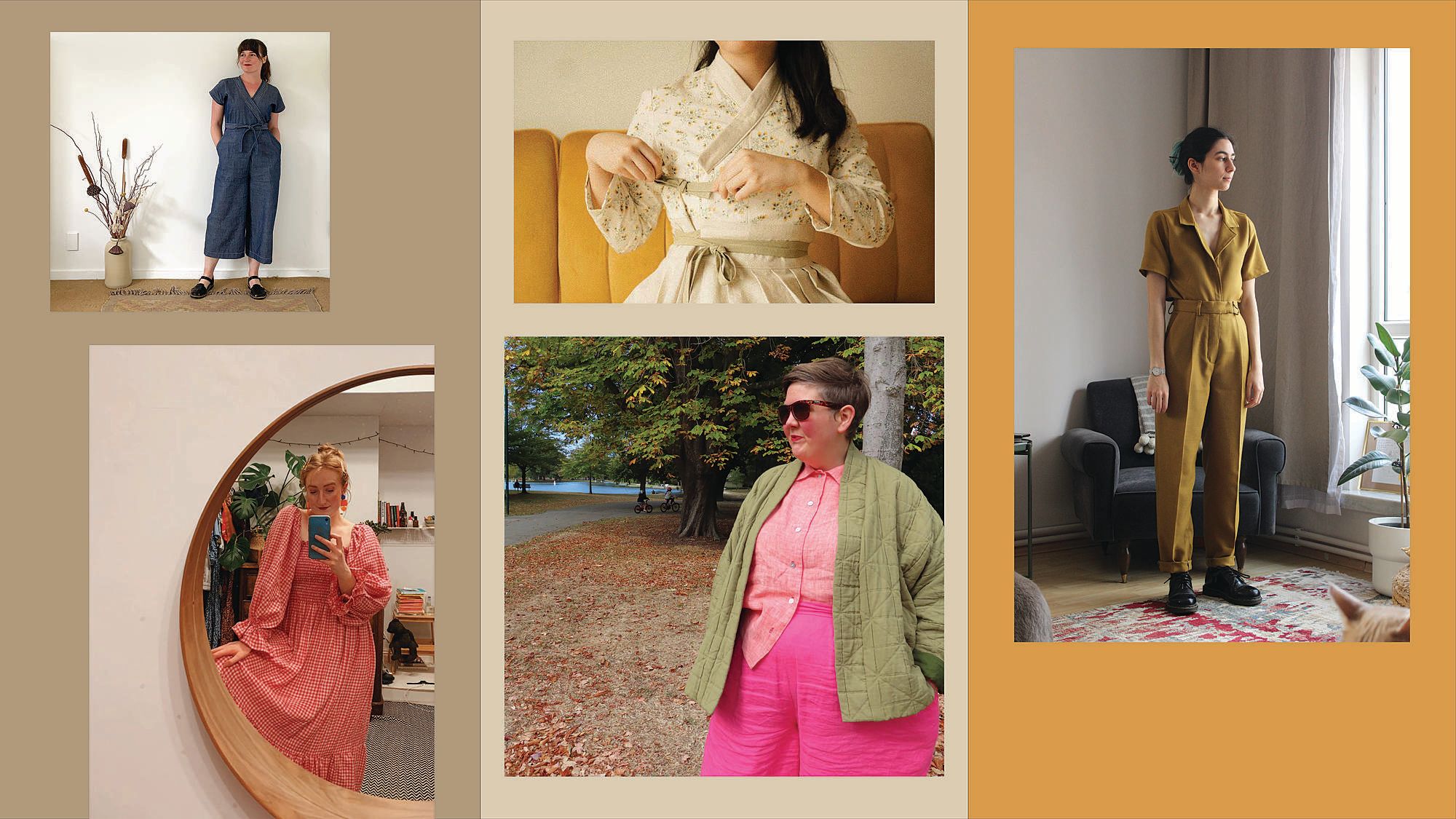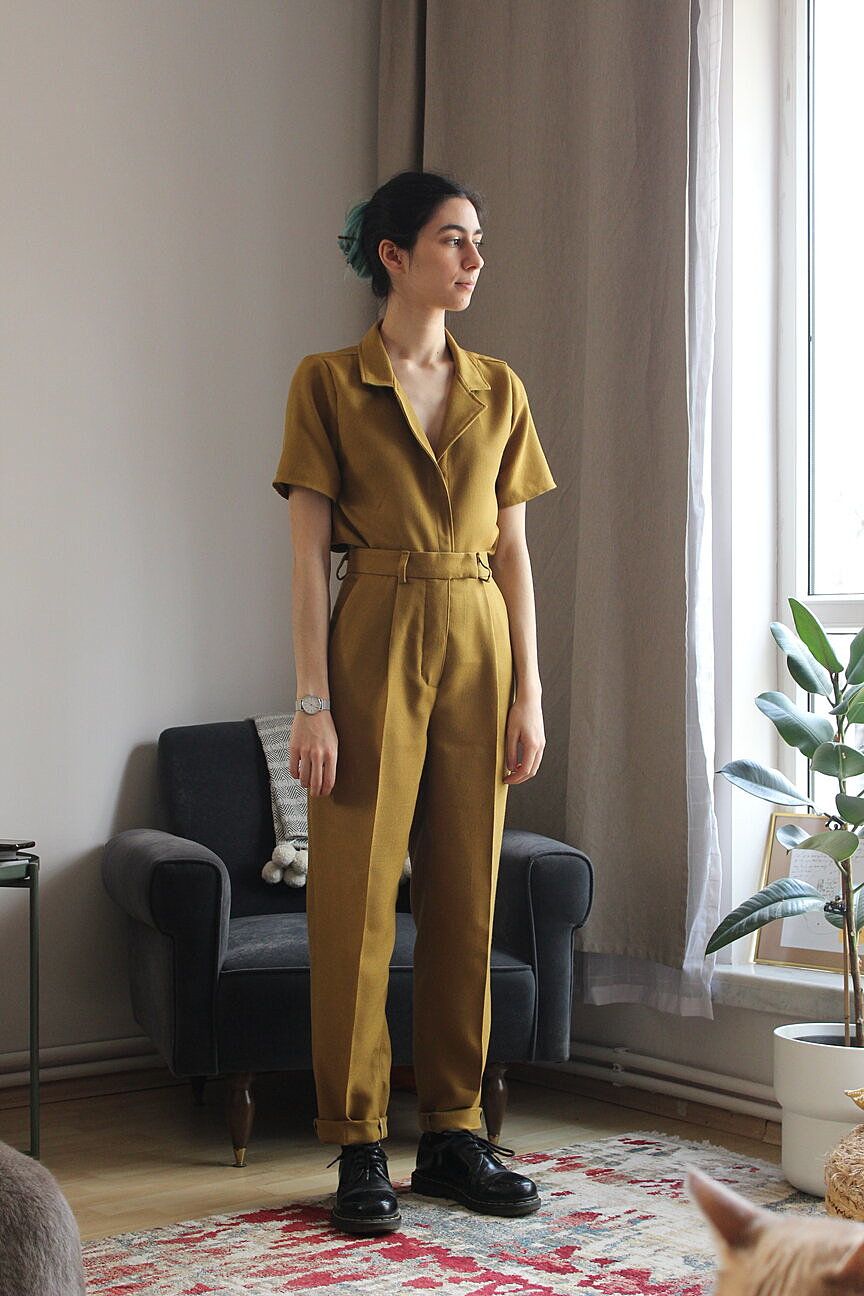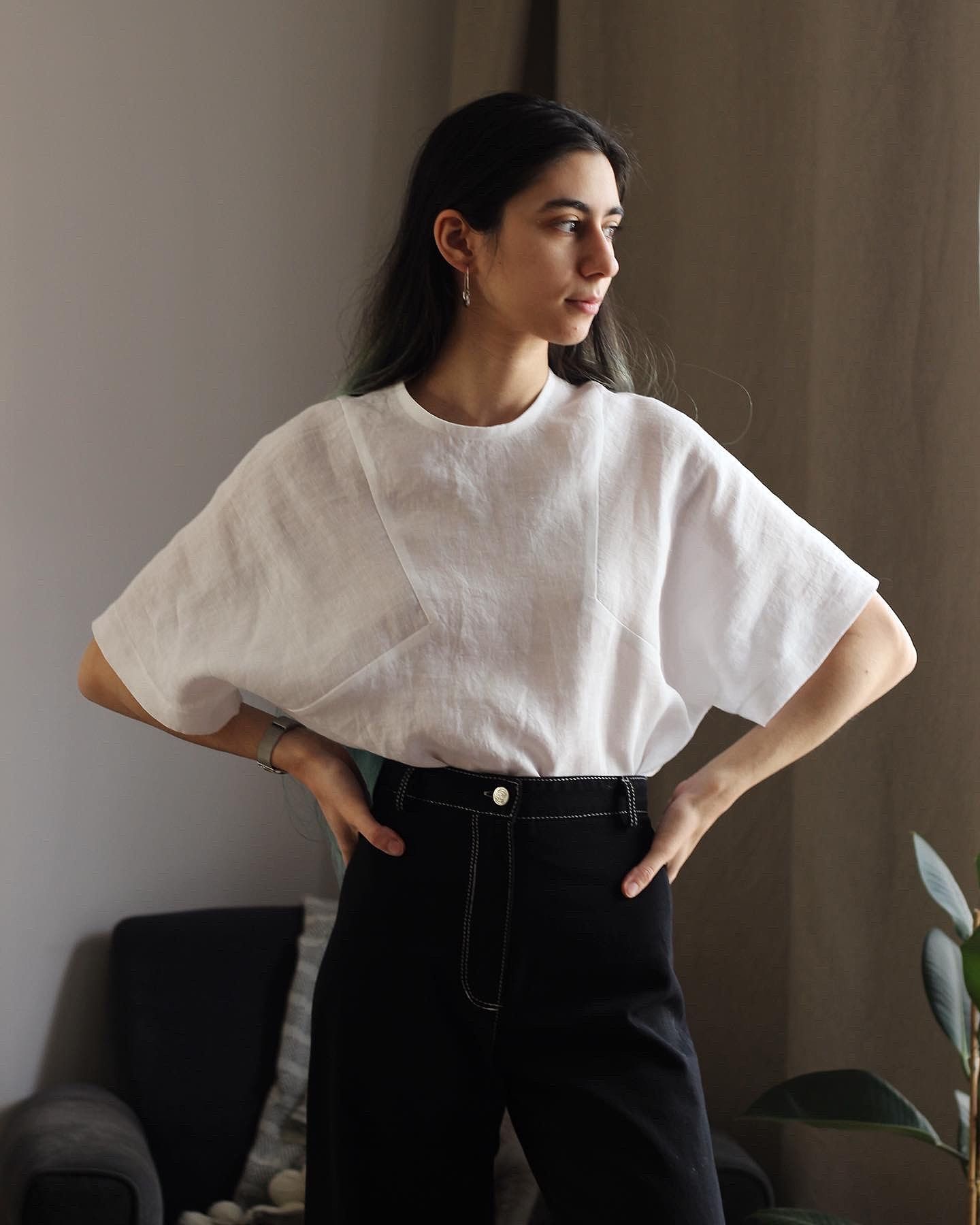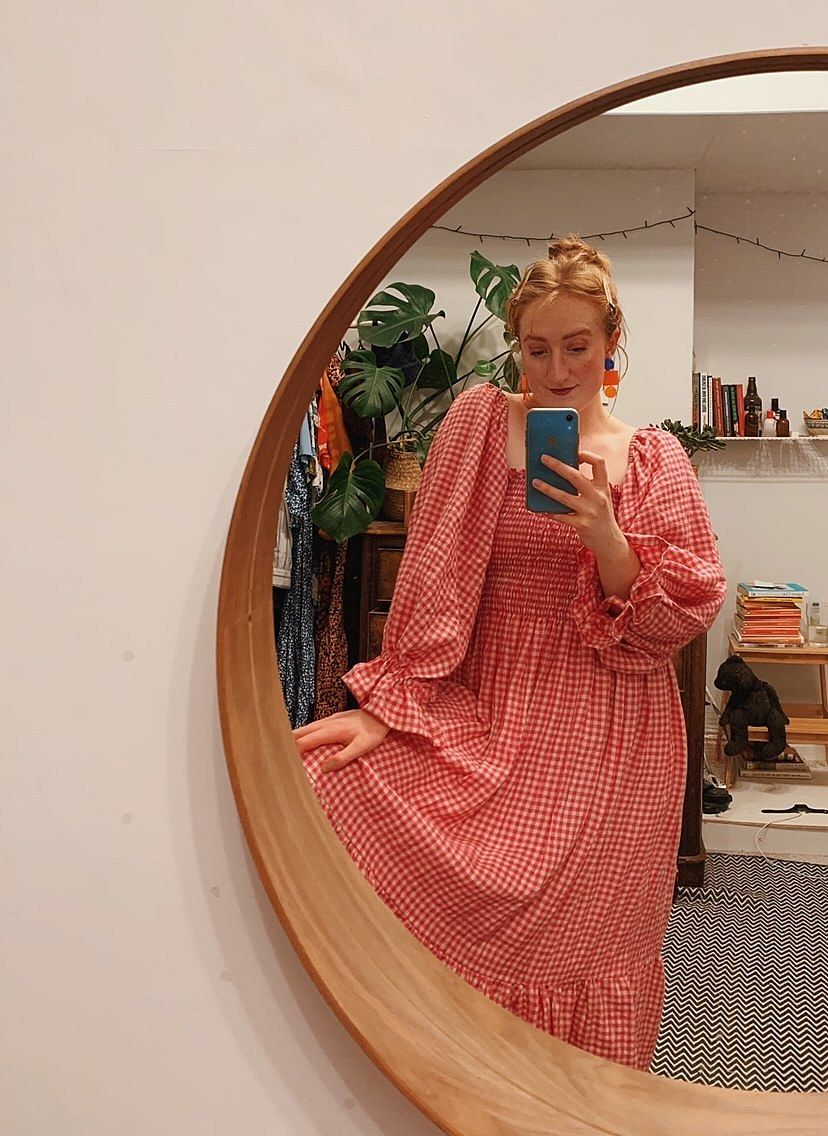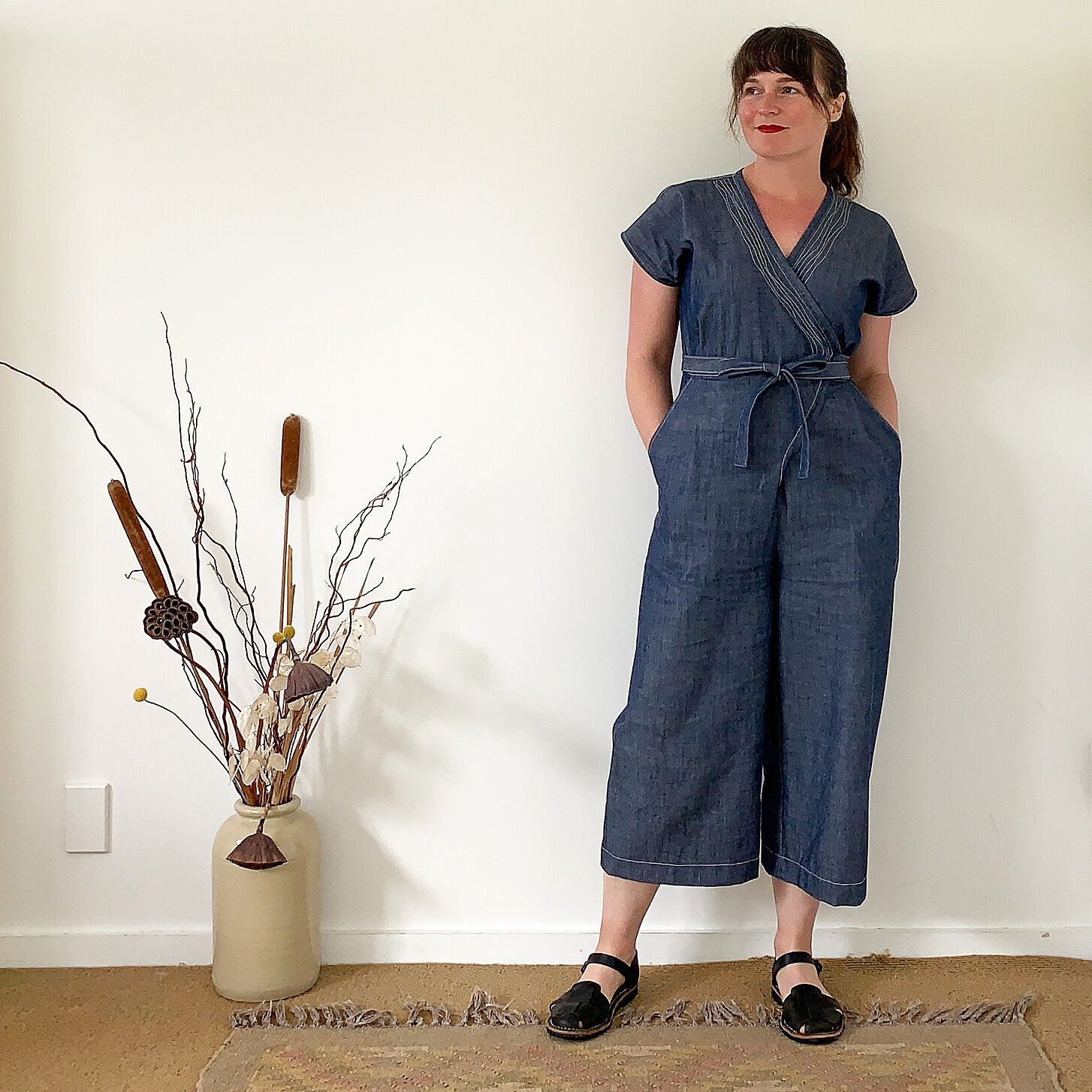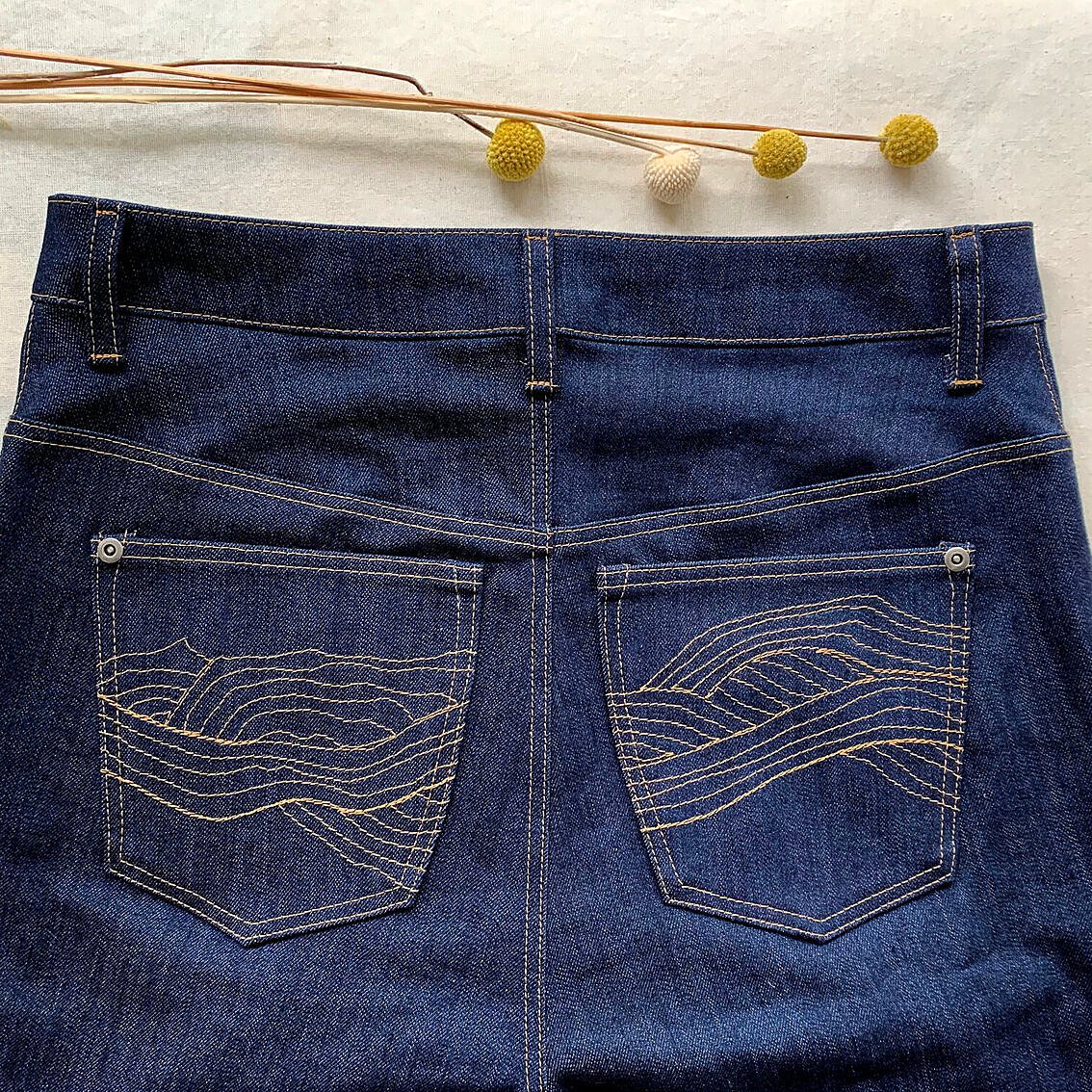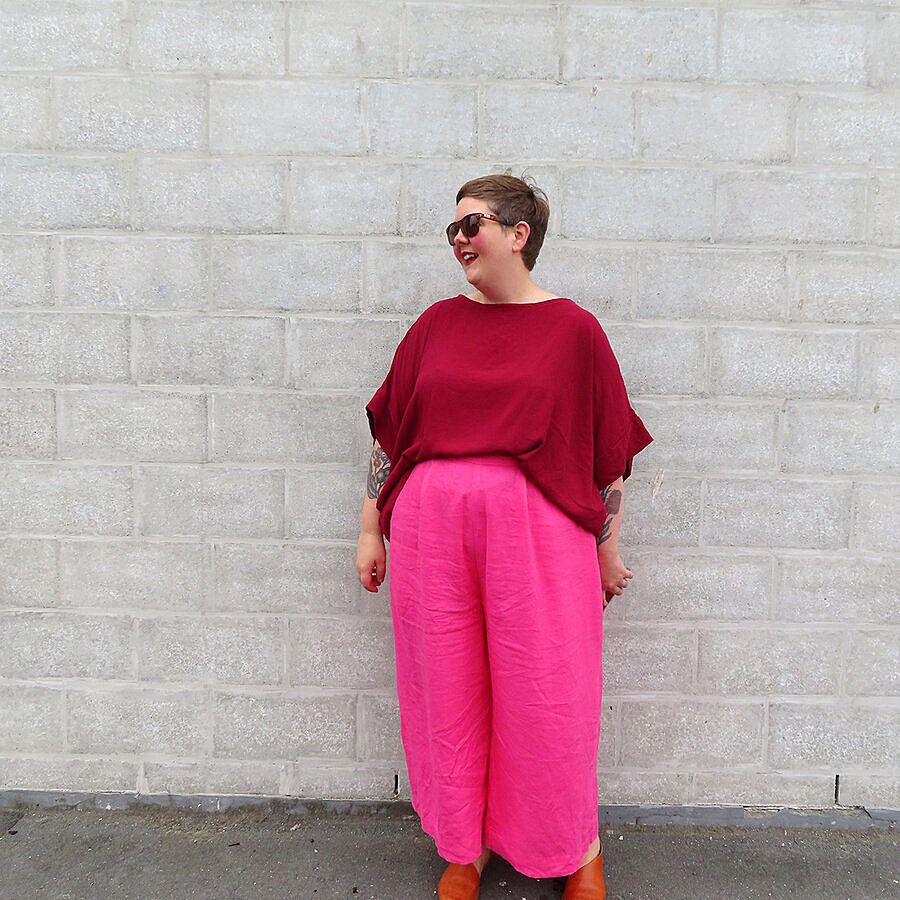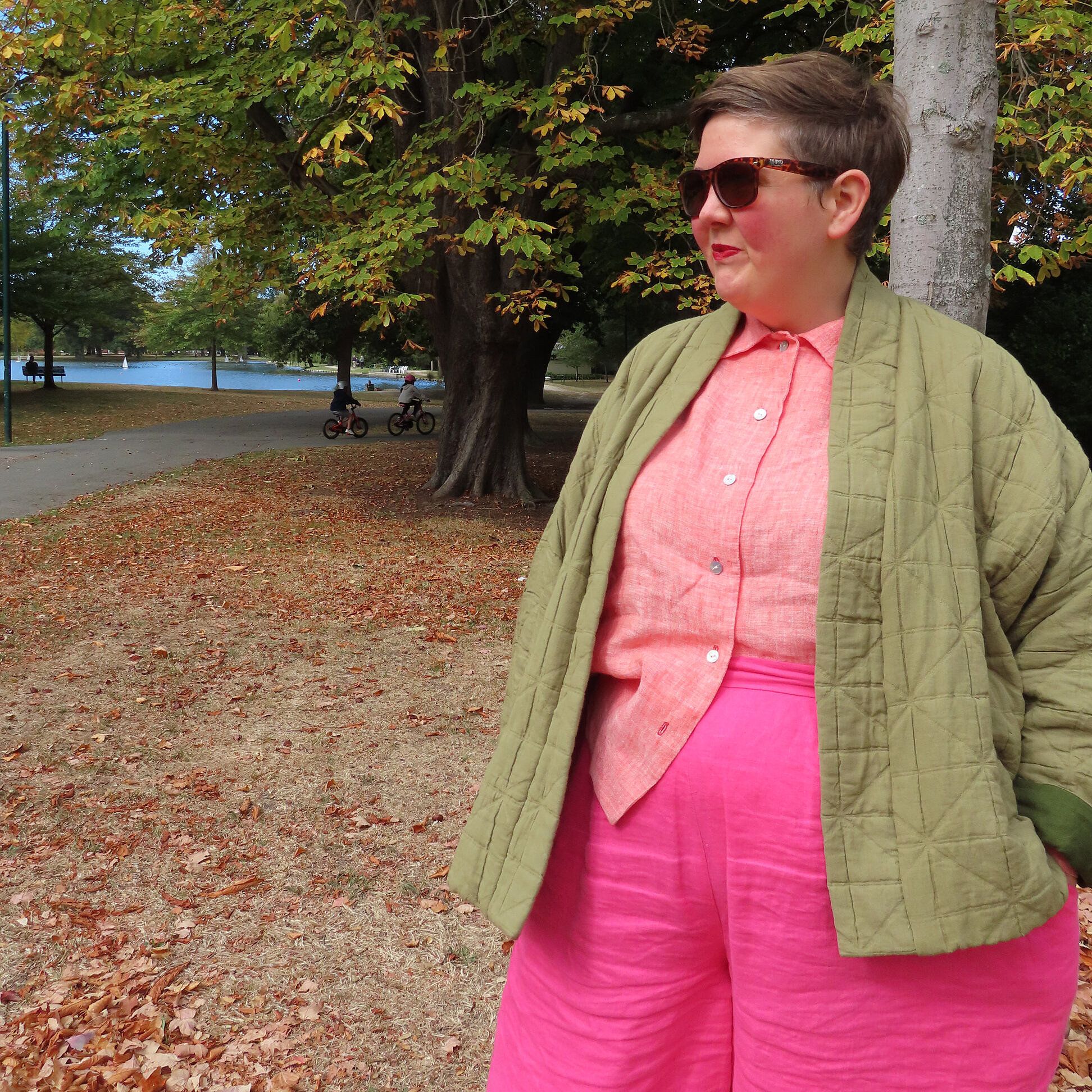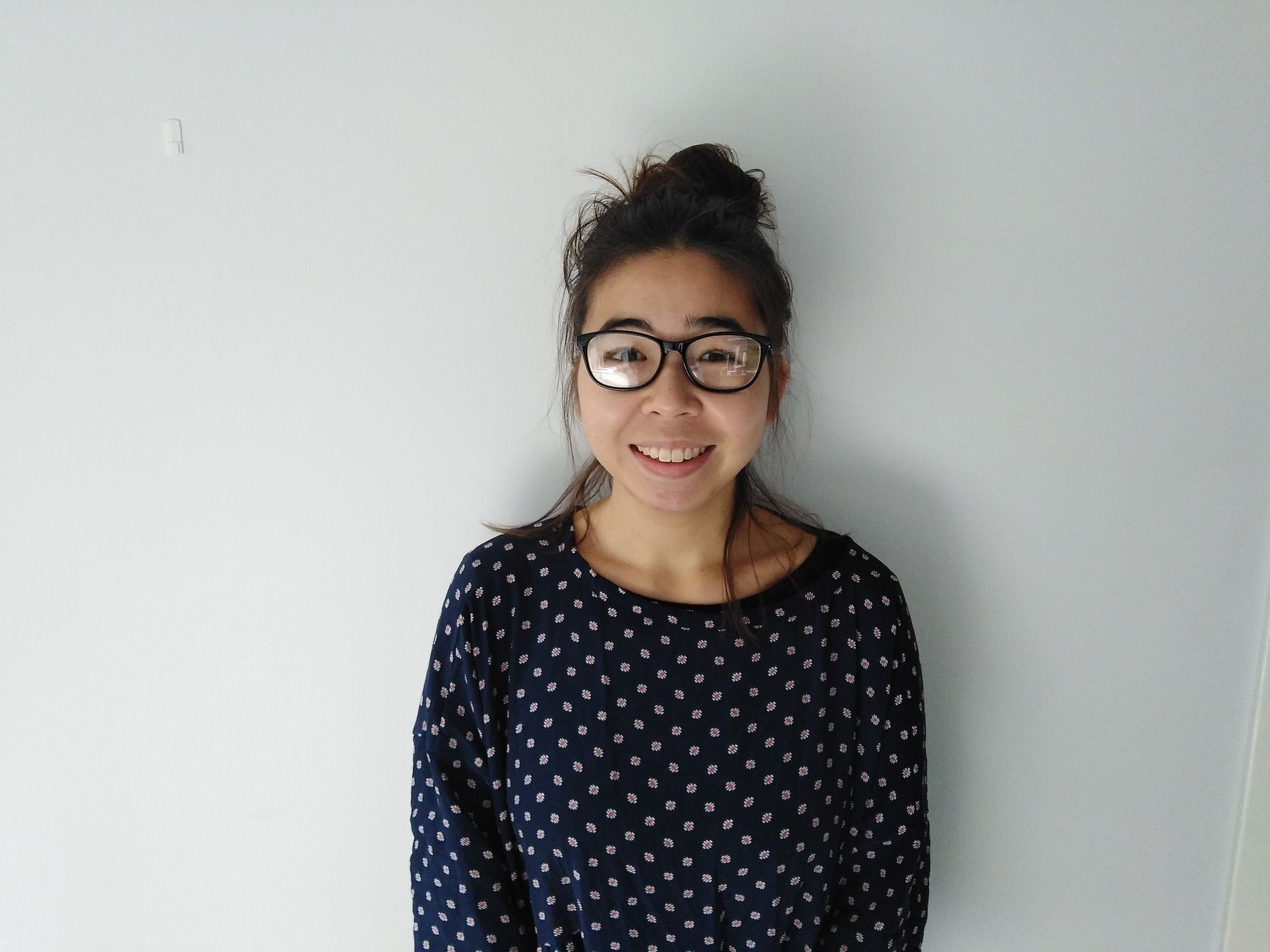We Should All be Sewists
Madeleine Ballard found an irrational love of sewing during lockdown, and now she’s part of a politically engaged community, handmaking what could be the nicest corner of the internet.
Last August, my partner’s mother taught me to sew. We’d been living with her in New Plymouth since returning from a Covid-stricken London, and I was feeling unmoored, living a life composed primarily of half-eaten toast and tired cover letters. “You just bring it up and over this hook, then through the eye,”she said, threading her mother’s ancient machine. “Then you set the fabric under here and step on the gas.” I hemmed a top, watching the thread spool out and out in neat, reassuring stitches. Maybe I can do this.
Nine months later, half my wardrobe is handmade. I’ve sewn masks and dresses and progressively less wonky pants. I’ve filled my wardrobe with high-waisted garments and dark green and dramatic sleeves, things I love irrationally. I sew a little bit almost every day, and the act has become precious to me: one of the only ways I know of to unwind and create at once.
It turns out I’m not the only one with thread all over my carpet. Last year, Aotearoa experienced a sewing boom, part of a global trend. During the second lockdown, clicks on sewing machine ads shot up 70 percent and there was a national elastic shortage as people rushed to make their own masks. Far from suffering during lockdown, fabric retailers saw sales remain buoyant or even increase: Emma Smith, owner of Greytown’s Miss Maude Sewing Store, says she had “a wonderful community of customers who were incredibly supportive during Level 4 and have continued to be since.”
You can make the kind of garment you’ve always wanted: one that lovingly clasps your God-given arse
And I’m not sure the hard data is all that matters. You just need to look at Instagram, where pun-handled sewing accounts (@the.sewcialite, @go.your.sewn.way) have multiplied since #memademay2020, and where tags for popular patterns like McCall’s #m7969 dress and Anna Allen’s #persephone pants number in the thousands.
Why was there a sewing boom? Why, to paraphrase one of my (loving and well-meaning) friends, would you spend hours making something you could buy a better version of? What is the particular alchemy that spins fabric and thread into joy for so many people?
I’d be lying to say I was not initially attracted to sewing by aesthetics. The names of fabric colours alone – dusk, citrus, calamity grey – are a kind of poetry. Then there's the fabrics themselves: liquid silks and viscoses, wash-wrinkled linen, wool gabardine that softens all the light that touches it. You can use such textiles to make the kind of well-fitting garment you’ve always wanted to find in a shop: one that highlights your waist; has plentiful, deep pockets; lovingly clasps your God-given arse.
“Growing up I struggled to find clothes that fit me properly, and I hardly ever found garments that felt like ‘me’ in the stores,” says Nisan (@the.social.fabric), an Ankara-based sewist who describes her crisply tailored style as “androgynous 80s archaeology professor going on a museum date.” “I love that I finally get to wear the clothes I always dreamed of wearing. My clothes feel more like an extension of my self and body this way, instead of being disposable pieces of fabric.” The promise of sewing – beautiful clothing that makes you feel more like yourself – is one of the most seductive I’ve ever come across.
Nisan wears self-drafted pants and a Helen’s Closet Patterns Gilbert Top, both in vintage chartreuse linen gifted by her grandmother
Nisan wears a Paper Theory Block Tee in white linen and Anna Allen Persephone Pants in black twill with cream top-stitching
Sewing is also beguilingly slow. It takes hours to make all but the simplest garments from scratch, and the process is curiously absorbing – both obvious draws in a lockdown. Netty (@small.sews), a sewist in movement-restricted Seattle, has worked from home for several months. “I loved that sewing was a hands-on process and forced me to work and think outside the boundaries of a 2D screen,” she told me. “The process also requires so much attention that it helps take my mind off things.”
But even beyond lockdowns, the slowness of sewing feels like a gift. You print the pattern, tape it together, trace it onto your fabric, cut it out. You sew the first seam and the second and the third – and eventually, you have something wearable: a tangible expression of both your labour and your taste. Everything about the process is deliberate and controlled in a way contemporary life rarely is. You choose the fabric and pattern; if something doesn’t fit, you change it; if you make a mistake, you can always unpick.
Sewing offers the sewist a sense of ownership, achievement and, ultimately, calm. Wellington-based sewist Gabrielle (@bibbity_bobbity_buttons) thinks of sewing as “a productive form of fidgeting”, while Miss Maude’s Emma told me sewing reliably delivers a certain catharsis, even helping her recover from postnatal depression. In an era that privileges convenience above all, sewing feels like a lesson in taking your time. Sewists learn not just to make clothes, but also to be patient and gentle.
The sewing community has made me think about the layers of privilege that have accreted on me as a straight, cis-gendered, able-bodied, economically advantaged white person who fits in the size bands of virtually all clothing and pattern companies
It’s also liberating to do something creative that’s simultaneously practical; that’s useful. Writing, my primary creative practice, can be truthful and empathetic and intellectual and beautiful, but nothing I produce will physically stop someone getting wet in the rain. Plus, as Gabrielle puts it, “the engineering of sewing is just so gratifying. The contrivance that takes a flat length of cloth and, through a series of clever shapes and cuts and stitch-lines, makes a three-dimensional garment never ceases to delight me.” The technical puzzles of sewing are so different from those of writing, and, at least for me, so much easier to solve. To have both in my life is immensely fulfilling.
Theoretically, sewing your own clothes is also more sustainable. Tara Viggo, the Cook Island Kiwi behind London-based pattern company Paper Theory, points out that home sewists can make too much: “it’s still possible to overshop raw materials and get sucked into making every trend you see on social media, so you still end up consuming far more than you need.” But sewing “demands a lot of time, thought and attention,” she says, which slows down consumption.
Similarly, for UK-based sewist Roisin (@giveherpockets), who works in climate change policy and flower farming, sewing is a way to manage your consumption – although she recognises that sustainability isn’t equally accessible to everyone. “I pretty much only buy deadstock fabric and I try to buy organic if I’m buying fibres that are less good for the environment, like cotton,” she told me. “But there’s a huge privilege in being able to do that. I’m very fortunate not to have to pay very much for my rent and bills, so I can spend more on making my sewing practice sustainable.”
Roisin wears her self-drafted Birthday Dress in Merchant & Mills pink gingham
Sewing can be an expensive hobby, and the fact that more economically accessible sewing options such as repairing are not considered ‘sexy’ only worsens the problem, she says. But for the individual sewist, making your own clothes can be extremely sustainable. “I love the freedom it gives me to be able to make whatever I want,” says Roisin. “Sewing allows me to take control over my carbon footprint and ethical footprint in a way I didn’t feel like I had control over before.”
But the most magical part of sewing is the community – one that is, at its best, remarkably inclusive and politically engaged. The Instagram sewing community is “probably the nicest corner of the internet”, according to Nisan. “I literally go into other people’s comments sections when I feel down, because there are always such beautiful displays of friendship and appreciation happening in the comments.”
Gabrielle wears her Paper Theory Zadie Jumpsuit in Cone Mills chambray
A detail shot of Gabrielle’s Megan Nielsen Ginger Jeans in Cone Mills stretch denim, with decorative top-stitching
Gabrielle points out that as a microcosm of wider society, the sewing world contains elements of “racism, fatphobia, transphobia, homophobia, ableism, [and] prejudices of all kinds”. But the strongest part of the community “flat refuses to ‘stick to our knitting’,” she told me. “The sewing community has made me think about the layers of privilege that have accreted on me as a straight, cis-gendered, able-bodied, economically advantaged white person who fits in the size bands of virtually all clothing and pattern companies.” In turn, she told me, her sewing experiences have “made me more politically active in daily life”.
It’s precisely this kind of awareness, coupled with the insistence of individual sewists on their right to feel good about their bodies, their identities, their aesthetics, that characterises the best of the sewing community. It feels like an arena in which the listening is largely sincere, virtue signalling is backed by genuine compassion, and change actually happens – I think of recent pattern name changes in the wake of violence against people of Asian appearance (see, for example, Tara Viggo’s blog post on her decision to rename the Kabuki Tee), and many pattern companies’ development of a wider size range and a more inclusive cast of models.
Sewing offers a space to make clothes that unapologetically fit fat bodies
What appeals to me most about sewing is how proudly sewists exhibit their identities, and how celebrated they are for doing so. Christchurch-based Jess (@fat.bobbin.girl) started sewing four years ago “because it was basically impossible to find natural fibre clothes in my size”. She now runs Muna & Broad along with Canada-based sewist Leila (@leila_sews), a pattern company for plus-size (12+) bodies. Their website is one of the most fat-friendly spaces I’ve ever encountered on the internet, and testament to the body positivity sewing encourages: Jess and Leila offer not only free and pay-what-you-can patterns, but also pattern grading for people larger than their existing size range.
For Jess, sewing offers a space to make clothes that unapologetically fit fat bodies, and to reckon with the complexities of body politics. “I love how people bring their whole selves to their making,” she told me. “I’ve learnt so much about gender expression, anti-fat bias, racism, and so much more from my real-life and internet sewing friends.” The enormous positive engagement she receives on Instagram and Patreon suggests others are hungry to talk about body politics, too.
Jess wears a Torrens Box Top in red rayon crepe and Glebe Pants in pink linen. Both patterns from Muna & Broad and both fabrics from The Fabric Store
Jess wears a modified Belmore Jacket in Merchant & Mills quilted green jacquard, a Waikerie Shirt in peach linen, and Glebe Pants in pink linen. All patterns from Muna & Broad
For Netty, meanwhile, sewing is a new way of connecting with her cultural heritage. I gasped out loud when I first saw her beautiful hanbok dress, based on a traditional Korean garment.
Netty describes the project as one of deep cultural significance. “Growing up as an Asian-American, I don’t think I fully understood the importance of my cultural heritage until I was older. A hanbok back then to me was just a pretty dress, but as an adult, I understand how important maintaining my cultural identity is,” she told me. “I don’t wear the hanbok dress day to day but it makes me proud to have made something so culturally significant with my own hands,” she said. As an Asian sewist myself, I was thrilled to see Netty’s dress amid the usual #cielotops and #pomonapants on my feed, and with so many encouraging comments from sewists around the world. It felt like a celebration; like fearlessness.
Netty wears her handmade Hanbok Dress, pattern and fabric from Dailylike Canada
From what I’ve observed, the sewing community is full of people articulating – and being celebrated for articulating – their identities. There are sewists of every size, gender, sexuality, race, age and aesthetic, and there’s space for all of us because every home-sewn garment is bespoke anyway: clothing has to fit you, rather than you fitting it. Echoing Nisan, I’m constantly touched by how genuinely sewists celebrate each other – not just because they swap technical tips and take inspiration from each other, but because difference is something to particularly value in a community based on aesthetics. It wouldbe boring if all sewists had identical bodies and made the same clothes.
Making my own clothes has given me a way out of my head in a difficult year, and it’s helped me articulate my values, validate my aesthetic tastes, and live out my environmental ethics. I’m not sure I’ve ever found a hobby that makes me feel so much like, and enjoy feeling like, myself. And I can’t encourage you enough to dig out your grandma’s Singer – or just sew that loose button back on.
